洪水调节设计模板-带试算c语言程序
- 格式:doc
- 大小:720.00 KB
- 文档页数:25
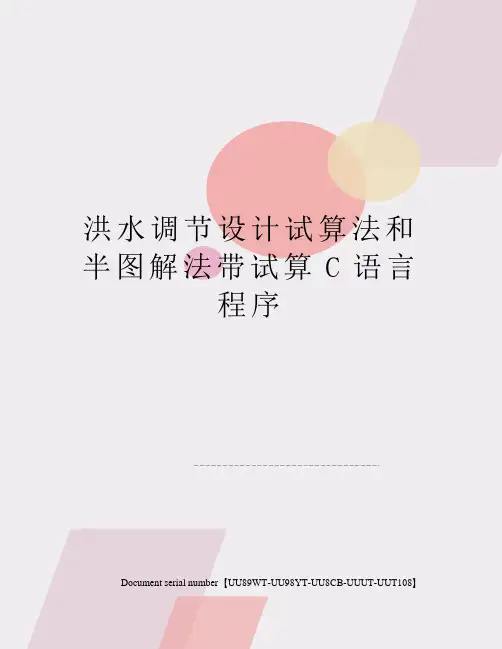
洪水调节设计试算法和半图解法带试算C语言程序Document serial number【UU89WT-UU98YT-UU8CB-UUUT-UUT108】《洪水调节课程设计》任务书一、设计目的1.洪水调节目的:定量地找出入库洪水、下泄洪水、拦蓄洪水的库容、水库水位的变化、泄洪建筑物型式和尺寸间的关系,为确定水库的有关参数和泄洪建筑型式选择、尺寸确定提供依据;2.掌握列表试算法和半图解法的基本原理、方法、步骤及各自的特点;3.了解工程设计所需洪水调节计算要解决的课题;培养学生分析问题、解决问题的能力。
二、设计基本资料1.某水利枢纽工程以发电为主,兼有防洪、供水、养殖等综合效益,电站装机为5000KW,年发电量1372×104kw·h,水库库容亿m3。
挡水建筑物为混凝土面板坝,最大坝高。
溢洪道堰顶高程,采用2孔8m×6m(宽×高)的弧形门控制。
水库正常蓄水位。
电站发电引用流量为10 m3/s。
2.本工程采用2孔溢洪道泄洪。
在洪水期间洪水来临时,先用闸门控制下泄流量q并使其等于洪水来水量Q,使水库水位保持在防洪限制水位不变;当洪水来水量Q继续增大时,闸门逐渐打开;当闸门达到全开后,就不再用闸门控制,下泄流量q随水库水位z的升高而增大,流态为自由流态,情况与无闸门控制一样。
3. 上游防洪限制水位(注:X=+学号最后1位/10,即),下游无防汛要求。
三、 设计任务及步骤分别对设计洪水标准、校核洪水标准,按照上述拟定的泄洪建筑物的类型、尺寸和水库运用方式,分别采用列表试算法和半图解法推求水库下泄流量过程,以及相应的库容、水位变化过程。
具体步骤:1. 根据工程规模和建筑物的等级,确定相应的洪水标准;2. 用列表试算法进行调洪演算:① 根据已知水库水位容积关系曲线V ~Z 和泄洪建筑物方案,用水力学公式求出下泄流量与库容关系曲线q ~Z ,并将V ~Z ,q ~Z 绘制在图上;② 决定开始计算时刻和此时的q 1、V 1,然后列表试算,试算过程中,对每一时段的q 2、V 2进行试算;③ 将计算结果绘成曲线:Q ~t 、q ~t 在一张图上,Z ~t 曲线绘制在下方。
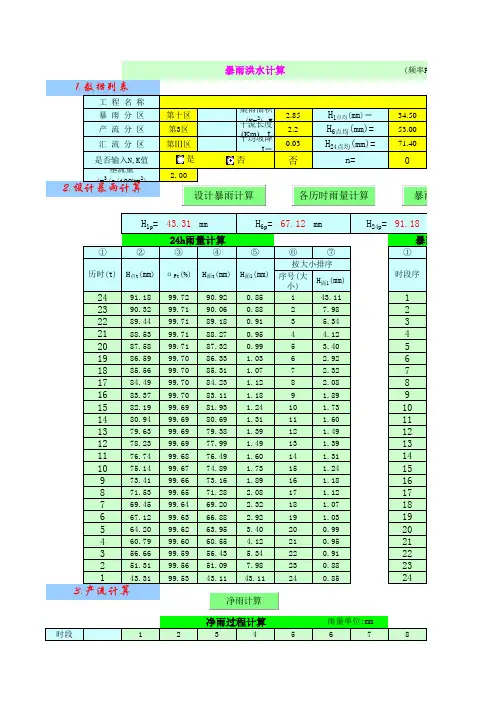
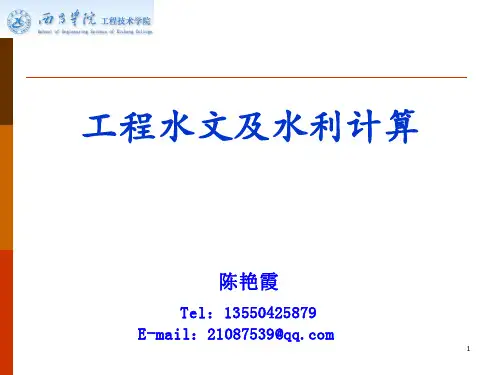
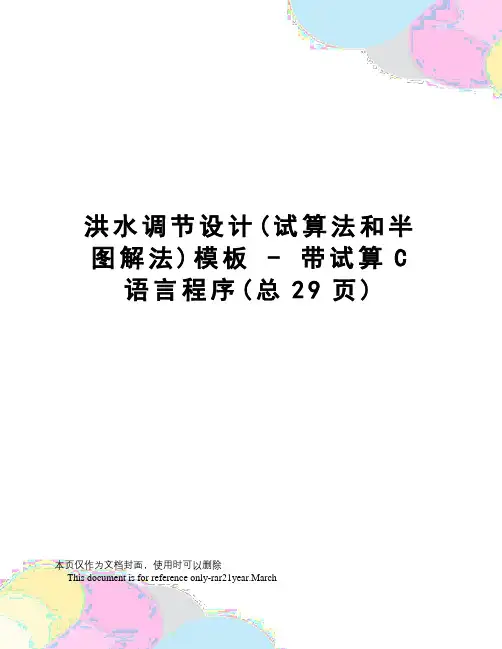
洪水调节设计(试算法和半图解法)模板-带试算C 语言程序(总29页)本页仅作为文档封面,使用时可以删除This document is for reference only-rar21year.March《洪水调节课程设计》任务书一、设计目的1.洪水调节目的:定量地找出入库洪水、下泄洪水、拦蓄洪水的库容、水库水位的变化、泄洪建筑物型式和尺寸间的关系,为确定水库的有关参数和泄洪建筑型式选择、尺寸确定提供依据;2.掌握列表试算法和半图解法的基本原理、方法、步骤及各自的特点;3.了解工程设计所需洪水调节计算要解决的课题;培养学生分析问题、解决问题的能力。
二、设计基本资料1.某水利枢纽工程以发电为主,兼有防洪、供水、养殖等综合效益,电站装机为5000KW,年发电量1372×104 kw·h,水库库容亿m3。
挡水建筑物为混凝土面板坝,最大坝高。
溢洪道堰顶高程,采用2孔8m×6m(宽×高)的弧形门控制。
水库正常蓄水位。
电站发电引用流量为10 m3/s。
2.本工程采用2孔溢洪道泄洪。
在洪水期间洪水来临时,先用闸门控制下泄流量q并使其等于洪水来水量Q,使水库水位保持在防洪限制水位不变;当洪水来水量Q继续增大时,闸门逐渐打开;当闸门达到全开后,就不再用闸门控制,下泄流量q随水库水位z的升高而增大,流态为自由流态,情况与无闸门控制一样。
3.上游防洪限制水位(注:X=+学号最后1位/10,即),下游无防汛要求。
三、设计任务及步骤分别对设计洪水标准、校核洪水标准,按照上述拟定的泄洪建筑物的类型、尺寸和水库运用方式,分别采用列表试算法和半图解法推求水库下泄流量过程,以及相应的库容、水位变化过程。
具体步骤:1.根据工程规模和建筑物的等级,确定相应的洪水标准;2.用列表试算法进行调洪演算:①根据已知水库水位容积关系曲线V~Z和泄洪建筑物方案,用水力学公式求出下泄流量与库容关系曲线q~Z,并将V~Z,q~Z绘制在图上;②决定开始计算时刻和此时的q1、V1,然后列表试算,试算过程中,对每一时段的q2、V2进行试算;③ 将计算结果绘成曲线:Q ~t 、q ~t 在一张图上,Z ~t 曲线绘制在下方。
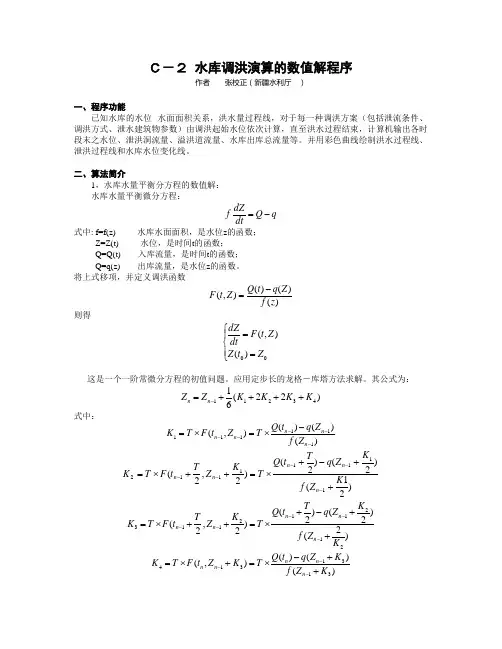
C-2 水库调洪演算的数值解程序作者 张校正(新疆水利厅 )一、程序功能已知水库的水位--水面面积关系,洪水量过程线,对于每一种调洪方案(包括泄流条件、调洪方式、泄水建筑物参数)由调洪起始水位依次计算,直至洪水过程结束,计算机输出各时段末之水位、泄洪洞流量、溢洪道流量、水库出库总流量等。
并用彩色曲线绘制洪水过程线、泄洪过程线和水库水位变化线。
二、算法简介1,水库水量平衡分方程的数值解:水库水量平衡微分方程:q Q dt dZ f -=式中: f=f(z) 水库水面面积,是水位z 的函数;Z=Z(t) 水位,是时间t 的函数;Q=Q(t) 入库流量,是时间t 的函数;Q=q(z) 出库流量,是水位z 的函数。
将上式移项,并定义调洪函数)()()(),(z f Z q t Q Z t F -=则得 ⎪⎩⎪⎨⎧==00)(),(Z t Z Z t F dt dZ 这是一个一阶常微分方程的初值问题。
应用定步长的龙格-库塔方法求解。
其公式为:)22(6143211K K K K Z Z n n ++++=-式中: )()()(),(111111------⨯=⨯=n n n n n Z f Z q t Q T Z t F T K)21()2()2()2,2(11111112K Z f K Z q T t Q T K Z T t F T K n n n n n ++-+⨯=++⨯=----- )2()2()2()2,2(212112113K Z f K Z q T t Q T K Z T t F T K n n n n n ++-+⨯=++⨯=----- )()()(),(3131314K Z f K Z q t Q T K Z t F T K n n n n n ++-⨯=+⨯=---T 为洪水流量时段间隔;n=1,2,……,J2,泄流量公式:当泄水建筑物为深孔时,)(2111111A C Z g B A M q --=式中:M 1 流量系数;A 1 泄流孔口高;B 1 泄流孔口宽;Z 水位;C 1 泄流孔口底槛高程。
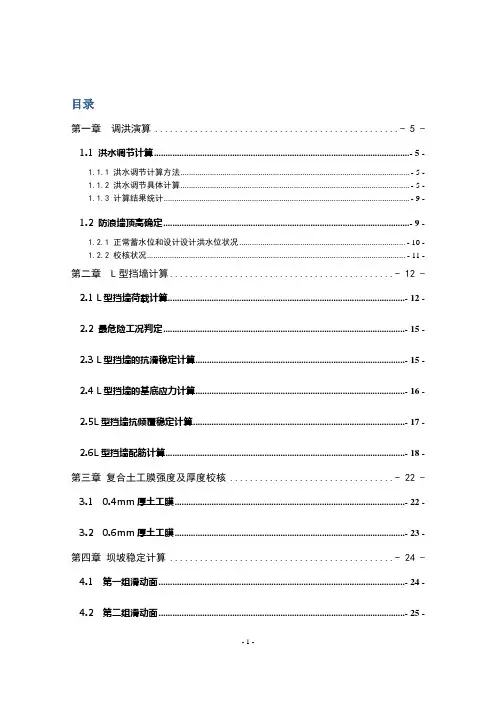
目录第一章调洪演算 .................................................- 4 -1.1 洪水调节计算............................................................................................................... - 4 -1.1.1 洪水调节计算方法............................................................................................................. - 4 -1.1.2 洪水调节具体计算............................................................................................................. - 4 -1.1.3 计算结果统计..................................................................................................................... - 8 -1.2 防浪墙顶高确定........................................................................................................... - 8 -1.2.1 正常蓄水位和设计设计洪水位状况................................................................................. - 9 -1.2.2 校核状况........................................................................................................................... - 10 -第二章 L型挡墙计算.............................................- 11 -2.1 L型挡墙荷载计算...................................................................................................... - 11 -2.2 最危险工况判定......................................................................................................... - 14 -2.3 L型挡墙的抗滑稳定计算.......................................................................................... - 14 -2.4 L型挡墙的基底应力计算.......................................................................................... - 15 -2.5L型挡墙抗倾覆稳定计算............................................................................................ - 16 -2.6L型挡墙配筋计算........................................................................................................ - 17 -第三章复合土工膜强度及厚度校核 .................................- 21 -3.1 0.4mm厚土工膜........................................................................................................ - 21 -3.2 0.6mm厚土工膜........................................................................................................ - 22 -第四章坝坡稳定计算 .............................................- 23 -4.1 第一组滑动面........................................................................................................... - 23 -4.2 第二组滑动面........................................................................................................... - 24 -4.3 第三组滑动面........................................................................................................... - 25 -4.4 第四组滑动面........................................................................................................... - 26 -4.6 第六组滑动面........................................................................................................... - 28 -第五章坝坡面复合土工膜稳定计算 .................................- 29 -5.1混凝土护坡与复合土工膜间抗滑稳定计算.............................................................. - 29 -5.2复合土工膜与下垫层间的抗滑稳定计算.................................................................. - 29 -第六章副坝设计 .................................................- 31 -6.1 副坝及主坝的连接及副坝型式选择................................................................................... - 31 -6.2 副坝的地基处理防渗设计................................................................................................... - 34 -第七章址板设计 .................................................- 35 -7.1 趾板剖面设计:......................................................................................................... - 35 -7.2 垂直段趾板稳定验算:............................................................................................. - 37 -7.4 坝体沉降估算.............................................................................................................. - 39 -第八章工程量清单计算 ...........................................- 40 -8.1主坝工程量计算表................................................................................................................. - 40 -8.2副坝工程量计算表................................................................................................................. - 41 -8.3工程量清单............................................................................................................................. - 42 -第九章地基处理及溢洪道设计(专题) ...............................- 44 -9.1副坝的地基处理防渗设计.......................................................................................... - 44 -9.2坝基处理...................................................................................................................... - 44 -9.2.1 坝基及岸坡开挖............................................................................................................... - 44 -9.2..2 固结灌浆......................................................................................................................... - 45 -9.2.3 帷幕灌浆及排水............................................................................................................... - 46 -9.3 溢洪道......................................................................................................................... - 46 -第十章拦洪水位确定 .............................................- 48 -10.1 洪水调节原理...................................................................................................................... - 48 -10.2 隧洞下泄能力曲线的确定.................................................................................................. - 48 -第十一章工程量计算 .............................................- 51 -11.1堆石体施工................................................................................................................ - 51 -11.1.1 施工强度计算................................................................................................................. - 51 -11.1.2工机械选择及数量分析.................................................................................................. - 54 -11.2混凝土工程量及机械数量计算................................................................................ - 56 -11.2.1 趾板................................................................................................................................. - 56 -11.2.2 混凝土面板..................................................................................................................... - 57 -11.2.3 挡浪墙............................................................................................................................. - 58 -11.2.4 副坝................................................................................................................................. - 58 -11.2.5 混凝土工程机械选择数量计算..................................................................................... - 58 -第十二章导流洞施工计算 .........................................- 60 -12.1基本资料............................................................................................................................... - 60 -12.2开挖方法选择....................................................................................................................... - 60 -12.3钻机爆破循环作业项目及机械设备的选择 ....................................................................... - 60 -12.4开挖循环作业组织............................................................................................................... - 60 -附图一:水位库容关系曲线 ........................................- 63 -附图二:坝址水位流量关系曲线 ....................................- 64 -附图三:设计洪水过程线 P=2% .....................................- 65 -附图四:校核洪水过程线 ...........................................- 66 -附图五: Q~H曲线(设计).......................................- 67 -堰顶高271米..................................................................................................................... - 67 -堰顶高272米..................................................................................................................... - 68 -堰顶高273米..................................................................................................................... - 69 -堰顶高274米..................................................................................................................... - 70 -附图六: Q~H曲线(校核).......................................- 71 -堰顶高271米..................................................................................................................... - 71 -堰顶高272米..................................................................................................................... - 72 -堰顶高273米..................................................................................................................... - 73 -堰顶高274米..................................................................................................................... - 74 -附图七:拦洪水位确定 ............................................- 75 -附图八:0.4mm土工膜厚度验算.....................................- 76 -纵向:................................................................................................................................. - 76 -横向:................................................................................................................................. - 76 -附图九:0.6mm土工膜厚度验算.....................................- 77 -纵向..................................................................................................................................... - 77 -横向..................................................................................................................................... - 77 -参考文献:......................................................- 78 -第一章 调洪演算1.1 洪水调节计算1.1.1 洪水调节计算方法利用瞬态法,结合水库特有条件,得初专用于水库调洪计算的实用公式如下: Q-q=△v/△t (1-1) 式中:Q — 计算时段中的平均入库流量(m 3/s );q — 计算时段中的平均下泄流量(m 3/s ); △v —时段初末水库蓄水量之差(m 3);√△t — 计算时段,一般取1-6小时,本设计取4小时。
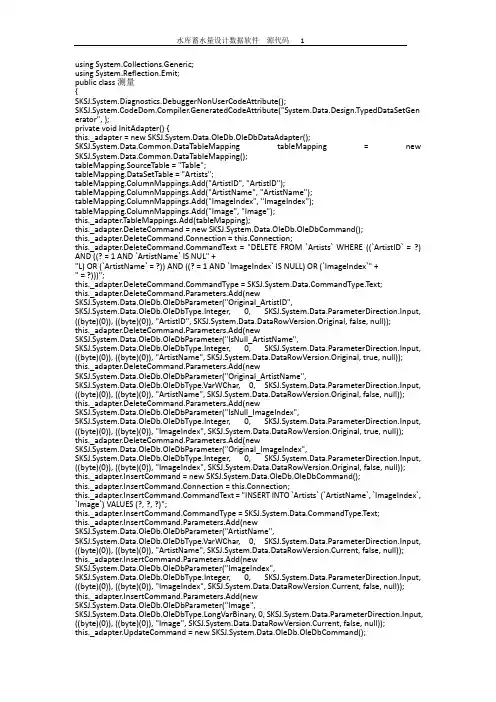
using System.Collections.Generic;using System.Reflection.Emit;public class测量{SKSJ.System.Diagnostics.DebuggerNonUserCodeAttribute();piler.GeneratedCodeAttribute("System.Data.Design.TypedDataSetGen erator", );private void InitAdapter() {this._adapter = new SKSJ.System.Data.OleDb.OleDbDataAdapter();mon.DataTableMapping tableMapping = new mon.DataTableMapping();tableMapping.SourceTable = "Table";tableMapping.DataSetTable = "Artists";tableMapping.ColumnMappings.Add("ArtistID", "ArtistID");tableMapping.ColumnMappings.Add("ArtistName", "ArtistName");tableMapping.ColumnMappings.Add("ImageIndex", "ImageIndex");tableMapping.ColumnMappings.Add("Image", "Image");this._adapter.TableMappings.Add(tableMapping);this._adapter.DeleteCommand = new SKSJ.System.Data.OleDb.OleDbCommand();this._adapter.DeleteCommand.Connection = this.Connection;this._mandText = "DELETE FROM `Artists` WHERE ((`ArtistID` = ?) AND ((? = 1 AND `ArtistName` IS NUL" +"L) OR (`ArtistName` = ?)) AND ((? = 1 AND `ImageIndex` IS NULL) OR (`ImageIndex`" +" = ?)))";this._mandType = mandType.Text;this._adapter.DeleteCommand.Parameters.Add(newSKSJ.System.Data.OleDb.OleDbParameter("Original_ArtistID",SKSJ.System.Data.OleDb.OleDbType.Integer, 0, SKSJ.System.Data.ParameterDirection.Input, ((byte)(0)), ((byte)(0)), "ArtistID", SKSJ.System.Data.DataRowVersion.Original, false, null));this._adapter.DeleteCommand.Parameters.Add(newSKSJ.System.Data.OleDb.OleDbParameter("IsNull_ArtistName",SKSJ.System.Data.OleDb.OleDbType.Integer, 0, SKSJ.System.Data.ParameterDirection.Input, ((byte)(0)), ((byte)(0)), "ArtistName", SKSJ.System.Data.DataRowVersion.Original, true, null)); this._adapter.DeleteCommand.Parameters.Add(newSKSJ.System.Data.OleDb.OleDbParameter("Original_ArtistName",SKSJ.System.Data.OleDb.OleDbType.VarWChar, 0, SKSJ.System.Data.ParameterDirection.Input, ((byte)(0)), ((byte)(0)), "ArtistName", SKSJ.System.Data.DataRowVersion.Original, false, null)); this._adapter.DeleteCommand.Parameters.Add(newSKSJ.System.Data.OleDb.OleDbParameter("IsNull_ImageIndex",SKSJ.System.Data.OleDb.OleDbType.Integer, 0, SKSJ.System.Data.ParameterDirection.Input, ((byte)(0)), ((byte)(0)), "ImageIndex", SKSJ.System.Data.DataRowVersion.Original, true, null)); this._adapter.DeleteCommand.Parameters.Add(newSKSJ.System.Data.OleDb.OleDbParameter("Original_ImageIndex",SKSJ.System.Data.OleDb.OleDbType.Integer, 0, SKSJ.System.Data.ParameterDirection.Input, ((byte)(0)), ((byte)(0)), "ImageIndex", SKSJ.System.Data.DataRowVersion.Original, false, null)); this._adapter.InsertCommand = new SKSJ.System.Data.OleDb.OleDbCommand();this._adapter.InsertCommand.Connection = this.Connection;this._mandText = "INSERT INTO `Artists` (`ArtistName`, `ImageIndex`, `Image`) VALUES (?, ?, ?)";this._mandType = mandType.Text;this._adapter.InsertCommand.Parameters.Add(newSKSJ.System.Data.OleDb.OleDbParameter("ArtistName",SKSJ.System.Data.OleDb.OleDbType.VarWChar, 0, SKSJ.System.Data.ParameterDirection.Input, ((byte)(0)), ((byte)(0)), "ArtistName", SKSJ.System.Data.DataRowVersion.Current, false, null)); this._adapter.InsertCommand.Parameters.Add(newSKSJ.System.Data.OleDb.OleDbParameter("ImageIndex",SKSJ.System.Data.OleDb.OleDbType.Integer, 0, SKSJ.System.Data.ParameterDirection.Input, ((byte)(0)), ((byte)(0)), "ImageIndex", SKSJ.System.Data.DataRowVersion.Current, false, null)); this._adapter.InsertCommand.Parameters.Add(newSKSJ.System.Data.OleDb.OleDbParameter("Image",SKSJ.System.Data.OleDb.OleDbType.LongVarBinary, 0, SKSJ.System.Data.ParameterDirection.Input, ((byte)(0)), ((byte)(0)), "Image", SKSJ.System.Data.DataRowVersion.Current, false, null));this._adapter.UpdateCommand = new SKSJ.System.Data.OleDb.OleDbCommand();this._adapter.UpdateCommand.Connection = this.Connection;this._mandText = "UPDATE `Artists` SET `ArtistName` = ?, `ImageIndex` = ?, `Image` = ? WHERE ((`Art" +"istID` = ?) AND ((? = 1 AND `ArtistName` IS NULL) OR (`ArtistName` = ?)) AND ((?" +" = 1 AND `ImageIndex` IS NULL) OR (`ImageIndex` = ?)))";this._mandType = mandType.Text;this._adapter.UpdateCommand.Parameters.Add(newSKSJ.System.Data.OleDb.OleDbParameter("ArtistName",SKSJ.System.Data.OleDb.OleDbType.VarWChar, 0, SKSJ.System.Data.ParameterDirection.Input, ((byte)(0)), ((byte)(0)), "ArtistName", SKSJ.System.Data.DataRowVersion.Current, false, null)); this._adapter.UpdateCommand.Parameters.Add(newSKSJ.System.Data.OleDb.OleDbParameter("ImageIndex",SKSJ.System.Data.OleDb.OleDbType.Integer, 0, SKSJ.System.Data.ParameterDirection.Input, ((byte)(0)), ((byte)(0)), "ImageIndex", SKSJ.System.Data.DataRowVersion.Current, false, null)); this._adapter.UpdateCommand.Parameters.Add(newSKSJ.System.Data.OleDb.OleDbParameter("Image",SKSJ.System.Data.OleDb.OleDbType.LongVarBinary, 0, SKSJ.System.Data.ParameterDirection.Input, ((byte)(0)), ((byte)(0)), "Image", SKSJ.System.Data.DataRowVersion.Current, false, null));this._adapter.UpdateCommand.Parameters.Add(newSKSJ.System.Data.OleDb.OleDbParameter("Original_ArtistID",SKSJ.System.Data.OleDb.OleDbType.Integer, 0, SKSJ.System.Data.ParameterDirection.Input, ((byte)(0)), ((byte)(0)), "ArtistID", SKSJ.System.Data.DataRowVersion.Original, false, null));this._adapter.UpdateCommand.Parameters.Add(newSKSJ.System.Data.OleDb.OleDbParameter("IsNull_ArtistName",SKSJ.System.Data.OleDb.OleDbType.Integer, 0, SKSJ.System.Data.ParameterDirection.Input, ((byte)(0)), ((byte)(0)), "ArtistName", SKSJ.System.Data.DataRowVersion.Original, true, null)); this._adapter.UpdateCommand.Parameters.Add(newSKSJ.System.Data.OleDb.OleDbParameter("Original_ArtistName",SKSJ.System.Data.OleDb.OleDbType.VarWChar, 0, SKSJ.System.Data.ParameterDirection.Input, ((byte)(0)), ((byte)(0)), "ArtistName", SKSJ.System.Data.DataRowVersion.Original, false, null)); this._adapter.UpdateCommand.Parameters.Add(newSKSJ.System.Data.OleDb.OleDbParameter("IsNull_ImageIndex",SKSJ.System.Data.OleDb.OleDbType.Integer, 0, SKSJ.System.Data.ParameterDirection.Input, ((byte)(0)), ((byte)(0)), "ImageIndex", SKSJ.System.Data.DataRowVersion.Original, true, null)); this._adapter.UpdateCommand.Parameters.Add(newSKSJ.System.Data.OleDb.OleDbParameter("Original_ImageIndex",SKSJ.System.Data.OleDb.OleDbType.Integer, 0, SKSJ.System.Data.ParameterDirection.Input, ((byte)(0)), ((byte)(0)), "ImageIndex", SKSJ.System.Data.DataRowVersion.Original, false, null));}SKSJ.System.Diagnostics.DebuggerNonUserCodeAttribute();piler.GeneratedCodeAttribute("System.Data.Design.TypedDataSetGen erator", );private void InitConnection() {this._connection = new SKSJ.System.Data.OleDb.OleDbConnection();this._connection.ConnectionString = SKSJ.DemoAppsHub.Properties.Settings.Default.MusicCollectionConnectionString;}SKSJ.System.Diagnostics.DebuggerNonUserCodeAttribute();piler.GeneratedCodeAttribute("System.Data.Design.TypedDataSetGen erator", );private void InitCommandCollection() {this._commandCollection = new SKSJ.System.Data.OleDb.OleDbCommand1;;this._commandCollection0; = new SKSJ.System.Data.OleDb.OleDbCommand();this._commandCollection0;.Connection = this.Connection;this._commandCollection0;.CommandText = "SELECT ArtistID, ArtistName, ImageIndex, Image; FROM Artists";this._commandCollection0;.CommandType = mandType.Text;}SKSJ.System.Diagnostics.DebuggerNonUserCodeAttribute();piler.GeneratedCodeAttribute("System.Data.Design.TypedDataSetGenerator", );ponentModel.Design.HelpKeywordAttribute("vs.data.TableAdapter");ponentModel.DataObjectMethodAttribute(ponentModel.Data ObjectMethodType.Fill, true);public virtual int Fill(MusicCollectionDataSet.ArtistsDataTable dataTable) {this.Adapter.SelectCommand = mandCollection0;;if ((this.ClearBeforeFill == true)) {dataTable.Clear();}int returnValue = this.Adapter.Fill(dataTable);return returnValue;}SKSJ.System.Diagnostics.DebuggerNonUserCodeAttribute();piler.GeneratedCodeAttribute("System.Data.Design.TypedDataSetGen erator", );ponentModel.Design.HelpKeywordAttribute("vs.data.TableAdapter");ponentModel.DataObjectMethodAttribute(ponentModel.Data ObjectMethodType.Select, true);public virtual MusicCollectionDataSet.ArtistsDataTable GetData() {this.Adapter.SelectCommand = mandCollection0;;MusicCollectionDataSet.ArtistsDataTable dataTable = new MusicCollectionDataSet.ArtistsDataTable();this.Adapter.Fill(dataTable);return dataTable;}SKSJ.System.Diagnostics.DebuggerNonUserCodeAttribute();piler.GeneratedCodeAttribute("System.Data.Design.TypedDataSetGen erator", );ponentModel.Design.HelpKeywordAttribute("vs.data.TableAdapter");public virtual int Update(MusicCollectionDataSet.ArtistsDataTable dataTable) {return this.Adapter.Update(dataTable);}SKSJ.System.Diagnostics.DebuggerNonUserCodeAttribute();piler.GeneratedCodeAttribute("System.Data.Design.TypedDataSetGen erator", );ponentModel.Design.HelpKeywordAttribute("vs.data.TableAdapter");public virtual int Update(MusicCollectionDataSet dataSet) {return this.Adapter.Update(dataSet, "Artists");}SKSJ.System.Diagnostics.DebuggerNonUserCodeAttribute();piler.GeneratedCodeAttribute("System.Data.Design.TypedDataSetGen erator", );//矢量元素ponentModel.Design.HelpKeywordAttribute("vs.data.TableAdapter");public virtual int Update(SKSJ.System.Data.DataRow dataRow) {return this.Adapter.Update(new SKSJ.System.Data.DataRow; {dataRow});}SKSJ.System.Diagnostics.DebuggerNonUserCodeAttribute();piler.GeneratedCodeAttribute("System.Data.Design.TypedDataSetGen erator", );ponentModel.Design.HelpKeywordAttribute("vs.data.TableAdapter");//设计数据模块数据删除public virtual int Update(SKSJ.System.Data.DataRow; dataRows) {return this.Adapter.Update(dataRows);}SKSJ.System.Diagnostics.DebuggerNonUserCodeAttribute();piler.GeneratedCodeAttribute("System.Data.Design.TypedDataSetGen erator", );ponentModel.Design.HelpKeywordAttribute("vs.data.TableAdapter");ponentModel.DataObjectMethodAttribute(ponentModel.Data ObjectMethodType.Delete, true);public virtual int Delete(int Original_ArtistID, string Original_ArtistName,SKSJ.System.Nullable<int> Original_ImageIndex) {this.Adapter.DeleteCommand.Parameters0;.Value = ((int)(Original_ArtistID));if ((Original_ArtistName == null)) {this.Adapter.DeleteCommand.Parameters1;.Value = ((object)(1));this.Adapter.DeleteCommand.Parameters2;.Value = SKSJ.System.DBNull.Value;}else {this.Adapter.DeleteCommand.Parameters1;.Value = ((object)(0));this.Adapter.DeleteCommand.Parameters2;.Value = ((string)(Original_ArtistName));}if ((Original_ImageIndex.HasValue == true)) {this.Adapter.DeleteCommand.Parameters3;.Value = ((object)(0));this.Adapter.DeleteCommand.Parameters4;.Value = ((int)(Original_ImageIndex.Value));}else {this.Adapter.DeleteCommand.Parameters3;.Value = ((object)(1));this.Adapter.DeleteCommand.Parameters4;.Value = SKSJ.System.DBNull.Value;}SKSJ.System.Data.ConnectionState previousConnectionState = this.Adapter.DeleteCommand.Connection.State;if (((this.Adapter.DeleteCommand.Connection.State & SKSJ.System.Data.ConnectionState.Open) != SKSJ.System.Data.ConnectionState.Open)) {this.Adapter.DeleteCommand.Connection.Open();//图标设计}try {int returnValue = this.Adapter.DeleteCommand.ExecuteNonQuery();return returnValue;}finally {if ((previousConnectionState == SKSJ.System.Data.ConnectionState.Closed)) {this.Adapter.DeleteCommand.Connection.Close();//要素}}}SKSJ.System.Diagnostics.DebuggerNonUserCodeAttribute();piler.GeneratedCodeAttribute("System.Data.Design.TypedDataSetGen erator", );ponentModel.Design.HelpKeywordAttribute("vs.data.TableAdapter");ponentModel.DataObjectMethodAttribute(ponentModel.Data ObjectMethodType.Insert, true);public virtual int Insert(string ArtistName, SKSJ.System.Nullable<int> ImageIndex, byte; Image) { if ((ArtistName == null)) {this.Adapter.InsertCommand.Parameters0;.Value = SKSJ.System.DBNull.Value;}else {this.Adapter.InsertCommand.Parameters0;.Value = ((string)(ArtistName));}if ((ImageIndex.HasValue == true)) {this.Adapter.InsertCommand.Parameters1;.Value = ((int)(ImageIndex.Value));}else {this.Adapter.InsertCommand.Parameters1;.Value = SKSJ.System.DBNull.Value;}if ((Image == null)) {this.Adapter.InsertCommand.Parameters2;.Value = SKSJ.System.DBNull.Value;}else {this.Adapter.InsertCommand.Parameters2;.Value = ((byte;)(Image));}SKSJ.System.Data.ConnectionState previousConnectionState = this.Adapter.InsertCommand.Connection.State;this.Adapter.InsertCommand.Connection.Open();}try {int returnValue = this.Adapter.InsertCommand.ExecuteNonQuery();return returnValue;}finally {if ((previousConnectionState == SKSJ.System.Data.ConnectionState.Closed)) {this.Adapter.InsertCommand.Connection.Close();}}}SKSJ.System.Diagnostics.DebuggerNonUserCodeAttribute();piler.GeneratedCodeAttribute("System.Data.Design.TypedDataSetGen erator", );ponentModel.Design.HelpKeywordAttribute("vs.data.TableAdapter");ponentModel.DataObjectMethodAttribute(ponentModel.Data ObjectMethodType.Update, true);//设计控制模块串口列表public virtual int Update(string ArtistName, SKSJ.System.Nullable<int> ImageIndex, byte; Image, int Original_ArtistID, string Original_ArtistName, SKSJ.System.Nullable<int> Original_ImageIndex) {if ((ArtistName == null)) {this.Adapter.UpdateCommand.Parameters0;.Value = SKSJ.System.DBNull.Value;}else {this.Adapter.UpdateCommand.Parameters0;.Value = ((string)(ArtistName));}if ((ImageIndex.HasValue == true)) {this.Adapter.UpdateCommand.Parameters1;.Value = ((int)(ImageIndex.Value));//设计数据模块模板}else {this.Adapter.UpdateCommand.Parameters1;.Value = SKSJ.System.DBNull.Value;}if ((Image == null)) {this.Adapter.UpdateCommand.Parameters2;.Value = SKSJ.System.DBNull.Value;}else {//进程并行运算this.Adapter.UpdateCommand.Parameters2;.Value = ((byte;)(Image));}this.Adapter.UpdateCommand.Parameters3;.Value = ((int)(Original_ArtistID));if ((Original_ArtistName == null)) {this.Adapter.UpdateCommand.Parameters4;.Value = ((object)(1));this.Adapter.UpdateCommand.Parameters5;.Value = SKSJ.System.DBNull.Value;}else {this.Adapter.UpdateCommand.Parameters4;.Value = ((object)(0));this.Adapter.UpdateCommand.Parameters5;.Value = ((string)(Original_ArtistName));}if ((Original_ImageIndex.HasValue == true)) {this.Adapter.UpdateCommand.Parameters6;.Value = ((object)(0));this.Adapter.UpdateCommand.Parameters7;.Value = ((int)(Original_ImageIndex.Value));}else {this.Adapter.UpdateCommand.Parameters6;.Value = ((object)(1));this.Adapter.UpdateCommand.Parameters7;.Value = SKSJ.System.DBNull.Value;}SKSJ.System.Data.ConnectionState previousConnectionState = this.Adapter.UpdateCommand.Connection.State;this.Adapter.UpdateCommand.Connection.Open();}try {int returnValue = this.Adapter.UpdateCommand.ExecuteNonQuery();return returnValue;}finally {if ((previousConnectionState == SKSJ.System.Data.ConnectionState.Closed)) {this.Adapter.UpdateCommand.Connection.Close();}}}}}//++++++/* 测量菜单*///线程内存益处using System.Text;using Telerik.WinForms.Documents.Model.BibliographicReferences;using System.Runtime.Remoting.Metadata;using System.Web.Mail;using System.IO.IsolatedStorage;public class测量菜单{#endregion//数据合集#region Close groupprivate void buttonCloseHeaderAndFooter_Click(object sender, EventArgs e){ExitHeaderFooterEditModeCommand command = new ExitHeaderFooterEditModeCommand(this.AssociatedRichTextEditor.RichTextBoxElement); this.ExecuteCommand(command);this.buttonCloseHeaderAndFooter.IsMouseOver = false;}#endregion#endregion//文本设置#region Otherprivate void dropDownButtonWithListViewMenuItem_DropDownClosing(object sender, RadPopupClosingEventArgs args){if (args.CloseReason == RadPopupCloseReason.Mouse){RadDropDownButtonElement dropDown = sender as RadDropDownButtonElement;foreach (RadItem item in dropDown.Items){ListViewMenuItem listViewItem = item as ListViewMenuItem;if (listViewItem != null && listViewItem.ListViewElement.ViewElement.VScrollBar.IsMouseOverElement){args.Cancel = true;break;}}}}private void RichTextBoxElement_ActiveDocumentEditorChanged(object sender, Telerik.WinForms.Documents.UI.ActiveDocumentEditorChangedEventArgs e){this.activeEditorCache.CurrentEditingStyleChanged -= ActiveEditor_CurrentEditingStyleChanged; mandExecuted -= ActiveEditor_CommandExecuted;e.NewActiveEditor.CurrentEditingStyleChanged += ActiveEditor_CurrentEditingStyleChanged; mandExecuted += ActiveEditor_CommandExecuted;}private void ActiveEditor_CommandExecuted(object sender, CommandExecutedEventArgs e) {this.HandleDocumentCommandExecuted(((RadRichTextBox)sender).Document);}//设计数据模块全局变量private void ActiveEditor_CurrentEditingStyleChanged(object sender, EventArgs e){this.HandleFontStylePropertiesOnCurrentEditingStyleChanged();this.HandleTableStylePropertiesOnCurrentEditingStyleChanged();}private void RichTextBoxElement_DocumentChanged(object sender, EventArgs e){mandExecuted -= Document_CommandExecuted;this.documentCache = this.associatedRichTextEditor.RichTextBoxElement.Document;//颜色设计管理mandExecuted += Document_CommandExecuted;this.HandleDocumentCommandExecuted(this.AssociatedRichTextEditor.RichTextBoxElement.Doc ument);this.SetQuickStyleItemSource(this.AssociatedRichTextEditor.RichTextBoxElement);this.SetListStyleItemSource(this.AssociatedRichTextEditor.RichTextBoxElement);this.SetTableStyleItemSource(this.AssociatedRichTextEditor.RichTextBoxElement);}private void Document_CommandExecuted(object sender, Telerik.WinForms.Documents.History.DocumentCommandExecutedEventArgs e){this.HandleDocumentCommandExecuted(sender as RadDocument);}private void RichTextBoxElement_IsInHeaderFooterEditModeChanged(object sender, EventArgs e){if (this.AssociatedRichTextEditor.RichTextBoxElement.IsInHeaderFooterEditMode){this.openTabCache = this.SelectedCommandTab;this.AssociatedRichTextEditor.RichTextBoxElement.CurrentEditingContext.PropertyChanged += CurrentEditingContext_PropertyChanged;mandTabs.Add(this.tabHeaderFooter);this.ContextualTabGroups.Add(this.tabGroupHeaderAndFooter);this.tabGroupHeaderAndFooter.TabItems.Add(this.tabHeaderFooter);this.tabHeaderFooter.IsSelected = true;}else{this.AssociatedRichTextEditor.RichTextBoxElement.CurrentEditingContext.PropertyChanged -= CurrentEditingContext_PropertyChanged;if (this.openTabCache != null){this.openTabCache.IsSelected = true;}else{this.tabHome.IsSelected = true;}mandTabs.Remove(this.tabHeaderFooter);this.tabHeaderFooter.IsSelected = false;this.ContextualTabGroups.Remove(this.tabGroupHeaderAndFooter);this.tabGroupHeaderAndFooter.TabItems.Remove(this.tabHeaderFooter);}}private void CurrentEditingContext_PropertyChanged(object sender,ponentModel.PropertyChangedEventArgs e){if (e.PropertyName == "Type" && this.AssociatedRichTextEditor.RichTextBoxElement.CurrentEditingContext.Type == Telerik.WinForms.Documents.UI.EditingContextTypes.HeaderFooter){this.linkToPrevious.ToggleStateChanged -= this.linkToPrevious_ToggleStateChanged;this.checkBoxDifferentFirstPage.ToggleStateChanged -= this.checkBoxDifferentFirstPage_ToggleStateChanged;this.checkBoxDifferentOddAndEvenPages.ToggleStateChanged -= this.checkBoxDifferentOddAndEvenPages_ToggleStateChanged;//文件载入this.spinElementHeaderFromTop.ValueChanged -= this.spinElementHeaderFromTop_ValueChanged;this.spinElementFooterFromBottom.ValueChanged -= this.spinElementFooterFromBottom_ValueChanged;if (this.AssociatedRichTextEditor.RichTextBoxElement.CurrentEditingContext.HeaderContext != null){Telerik.WinForms.Documents.UI.HeaderFooterEditingContext currentEditingContext = this.AssociatedRichTextEditor.RichTextBoxElement.CurrentEditingContext.HeaderContext;this.linkToPrevious.IsChecked = currentEditingContext.CurrentSection.IsHeaderLinkedToPrevious(currentEditingContext.CurrentH eaderFooterType);this.checkBoxDifferentFirstPage.IsChecked = currentEditingContext.CurrentSection.HasDifferentFirstPageHeaderFooter;this.spinElementHeaderFromTop.Value = currentEditingContext.CurrentSection.HeaderTopMargin;this.spinElementFooterFromBottom.Value = currentEditingContext.CurrentSection.FooterBottomMargin;//设计控制模块事件响应}else if (this.AssociatedRichTextEditor.RichTextBoxElement.CurrentEditingContext.FooterContext != null) {Telerik.WinForms.Documents.UI.HeaderFooterEditingContext currentEditingContext = this.AssociatedRichTextEditor.RichTextBoxElement.CurrentEditingContext.FooterContext;this.linkToPrevious.IsChecked = currentEditingContext.CurrentSection.IsFooterLinkedToPrevious(currentEditingContext.CurrentHe aderFooterType);this.checkBoxDifferentFirstPage.IsChecked = currentEditingContext.CurrentSection.HasDifferentFirstPageHeaderFooter;this.spinElementHeaderFromTop.Value = currentEditingContext.CurrentSection.HeaderTopMargin;this.spinElementFooterFromBottom.Value = currentEditingContext.CurrentSection.FooterBottomMargin;}this.checkBoxDifferentOddAndEvenPages.IsChecked = this.AssociatedRichTextEditor.RichTextBoxElement.Document.HasDifferentEvenAndOddHeadersF ooters;this.spinElementFooterFromBottom.ValueChanged += this.spinElementFooterFromBottom_ValueChanged;this.spinElementHeaderFromTop.ValueChanged += this.spinElementHeaderFromTop_ValueChanged;this.checkBoxDifferentOddAndEvenPages.ToggleStateChanged += this.checkBoxDifferentOddAndEvenPages_ToggleStateChanged;this.checkBoxDifferentFirstPage.ToggleStateChanged += this.checkBoxDifferentFirstPage_ToggleStateChanged;this.linkToPrevious.ToggleStateChanged += this.linkToPrevious_ToggleStateChanged;}}private Paragraph GetCurrentParagraph(){yout.ParagraphLayoutBox pb = this.GetCurrentParagraphBox();if (pb != null){return pb.AssociatedParagraph;}return null;}private yout.ParagraphLayoutBox GetCurrentParagraphBox() {if (this.RichTextBoxActiveEditor.Document.Selection.IsEmpty){yout.ParagraphLayoutBox pb = this.RichTextBoxActiveEditor.Document.CaretPosition.GetCurrentParagraphBox();return pb;}returnthis.RichTextBoxActiveEditor.Document.Selection.Ranges.First.StartPosition.GetCurrentParagraph Box();}#endregion#endregion#region Style galleryprotected override void OnNotifyPropertyChanged(string propertyName){base.OnNotifyPropertyChanged(propertyName);if (propertyName == "AssociatedRichTextEditor" && this.AssociatedRichTextEditor != null){this.InitializeSnapshotRichTextBox();this.InitializeListSnapshotRichTextBox();//设计数据模块信息日志}}private void observableStyleCollection_CollectionChanged(object sender, NotifyCollectionChangedEventArgs e){this.FillStylesGallery();}private void SetQuickStyleItemSource(RadRichTextBox radRichTextBox){if (this.observableStyleCollection != null){this.observableStyleCollection.CollectionChanged -= observableStyleCollection_CollectionChanged;this.observableStyleCollection.DetachEvents();}this.styleSnapshotRichTextBox.Dispatcher.BeginInvoke(new Action(() =>{this.SetInitialQuickStyleItemSource(radRichTextBox);}));//设计控制模块进程执行}private void SetInitialQuickStyleItemSource(RadRichTextBox radRichTextBox){if (radRichTextBox != null){this.observableStyleCollection = new Telerik.WinForms.RichTextEditor.RichTextBoxUI.Dialogs.Styles.ObservableStyleCollection(this.Ass ociatedRichTextEditor.Document, this.styleSnapshotRichTextBox, 200, 200, false, true);this.observableStyleCollection.CollectionChanged += observableStyleCollection_CollectionChanged;this.FillStylesGallery();}}private void FillStylesGallery(){foreach (StyleGalleryItem item in this.galleryStyles.Items){item.Click -= styleGalleryItem_Click;}this.galleryStyles.Items.Clear();foreach (Telerik.WinForms.RichTextEditor.RichTextBoxUI.Dialogs.Styles.StyleData style in this.observableStyleCollection){StyleGalleryItem item = new StyleGalleryItem(style.DisplayName, style);item.DisplayStyle = DisplayStyle.ImageAndText;item.TextImageRelation = System.Windows.Forms.TextImageRelation.ImageAboveText;item.MaxSize = new System.Drawing.Size(64, 64);item.MinSize = new System.Drawing.Size(64, 64);item.TextAlignment = ContentAlignment.BottomCenter;item.ClipDrawing = true;item.Click += styleGalleryItem_Click;this.galleryStyles.Items.Add(item);}//设计数据模块数据存储}}//-------------/* 定时测量*/using System.Web.UI.MobileControls;using RichTextEditor.Properties;using System.Collections;using System.Runtime.Serialization.Formatters;using System.Text;//设计控制模块全局变量public class定时测量{SKSJ.System.Diagnostics.DebuggerNonUserCodeAttribute();piler.GeneratedCodeAttribute("System.Data.Design.TypedDataSetGen erator", );protected override void InitializeDerivedDataSet() {this.BeginInit();this.InitClass();//存储区this.EndInit();}SKSJ.System.Diagnostics.DebuggerNonUserCodeAttribute();piler.GeneratedCodeAttribute("System.Data.Design.TypedDataSetGen erator", );public override SKSJ.System.Data.DataSet Clone() {SofiaCarRentalDataSet cln = ((SofiaCarRentalDataSet)(base.Clone()));cln.InitVars();cln.SchemaSerializationMode = this.SchemaSerializationMode;return cln;}SKSJ.System.Diagnostics.DebuggerNonUserCodeAttribute();piler.GeneratedCodeAttribute("System.Data.Design.TypedDataSetGen erator", );protected override bool ShouldSerializeTables() {return false;}SKSJ.System.Diagnostics.DebuggerNonUserCodeAttribute();piler.GeneratedCodeAttribute("System.Data.Design.TypedDataSetGen erator", );protected override bool ShouldSerializeRelations() {return false;}erator", );protected override void ReadXmlSerializable(SKSJ.System.Xml.XmlReader reader) {if ((this.DetermineSchemaSerializationMode(reader) == SKSJ.System.Data.SchemaSerializationMode.IncludeSchema)) {this.Reset();SKSJ.System.Data.DataSet ds = new SKSJ.System.Data.DataSet();ds.ReadXml(reader);if ((ds.Tables"Cars"; != null)) {base.Tables.Add(new CarsDataTable(ds.Tables"Cars";));}if ((ds.Tables"Categories"; != null)) {base.Tables.Add(new CategoriesDataTable(ds.Tables"Categories";));}if ((ds.Tables"Customers"; != null)) {base.Tables.Add(new CustomersDataTable(ds.Tables"Customers";));}if ((ds.Tables"Employees"; != null)) {base.Tables.Add(new EmployeesDataTable(ds.Tables"Employees";));//比例缩放}if ((ds.Tables"RentalOrders"; != null)) {base.Tables.Add(new RentalOrdersDataTable(ds.Tables"RentalOrders";));}if ((ds.Tables"RentalRates"; != null)) {base.Tables.Add(new RentalRatesDataTable(ds.Tables"RentalRates";));}if ((ds.Tables"CarsRatesDataTable"; != null)) {//查询base.Tables.Add(new CarsRatesDataTableDataTable(ds.Tables"CarsRatesDataTable";));}this.DataSetName = ds.DataSetName;this.Prefix = ds.Prefix;space = space;this.Locale = ds.Locale;this.CaseSensitive = ds.CaseSensitive;this.EnforceConstraints = ds.EnforceConstraints;//紧急设定this.Merge(ds, false, SKSJ.System.Data.MissingSchemaAction.Add);this.InitVars();}else {this.ReadXml(reader);this.InitVars();}}SKSJ.System.Diagnostics.DebuggerNonUserCodeAttribute();piler.GeneratedCodeAttribute("System.Data.Design.TypedDataSetGen erator", );protected override SKSJ.System.Xml.Schema.XmlSchema GetSchemaSerializable() {SKSJ.System.IO.MemoryStream stream = new SKSJ.System.IO.MemoryStream();this.WriteXmlSchema(new SKSJ.System.Xml.XmlTextWriter(stream, null));stream.Position = 0;return SKSJ.System.Xml.Schema.XmlSchema.Read(new SKSJ.System.Xml.XmlTextReader(stream), null);}SKSJ.System.Diagnostics.DebuggerNonUserCodeAttribute();piler.GeneratedCodeAttribute("System.Data.Design.TypedDataSetGen erator", );internal void InitVars() {this.InitVars(true);}。
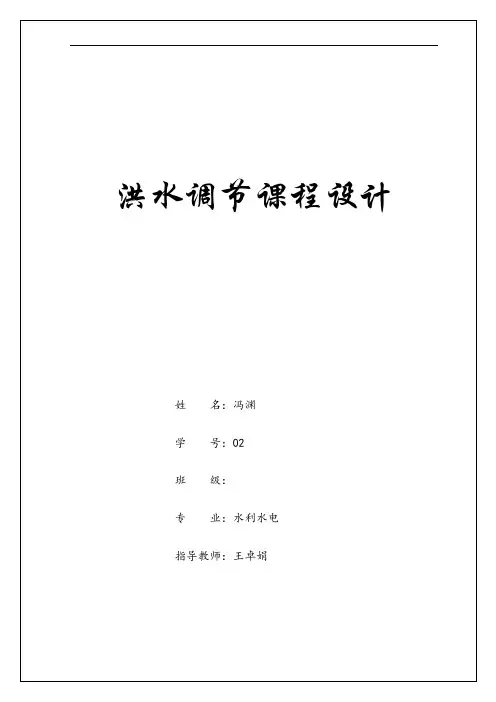
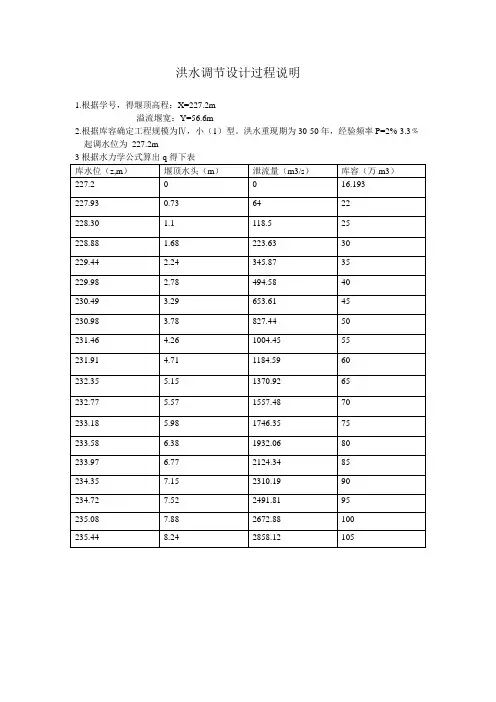
洪水调节设计过程说明1.根据学号,得堰顶高程:X=227.2m溢流堰宽:Y=56.6m2.根据库容确定工程规模为Ⅳ,小(1)型。
洪水重现期为30-50年,经验频率P=2%-3.3﹪起调水位为227.2m绘得q-z曲线,q-v曲线(1)试算法:由试算结果得出下表,下表为设计洪水计算表时间t( h)入库洪水流量Q(m3/s)时段平均入库流量(m3/s)时段平均入库水量(万m3)下泄流量q(m3/s)时段平均下泄流量(m3/s)时段下泄水量(万m3)时段库容变化量(万m3)水库存水量(万m3)水库水位(m)0 9.6 4.8 1.728 0 0 0 0 16.193 227.21 11.8 10.7 3.852 14.228 7.114 2.561 1.291 17.484 227.362 23.3 17.55 6.318 18.645 16.439 5.917 0.401 17.885 227.413 48.8 36.05 12.978 41.789 30.217 10.878 2.1 19.985 227.684 86.3 67.55 24.318 77.872 59.831 21.539 2.779 22.764 228.0245 132 109.15 29.294 126.017 101.945 36.7 2.594 25.358 228.3426 182.2 157.1 56.556 175.19 150.604 54.217 2.339 27.696 228.617 248.5 215.35 77.526 239.178 207.184 74.586 2.94 30.636 228.958 345.6 297.05 106.938 333.491 286.334 103.08 3.858 34.494 229.389 521 433.3 155.988 477.863 405.677 146.044 9.944 44.438 230.4310 888 704.5 253.62 866.352 672.108 241.959 11.661 56.099 231.5611 1300.6 1094.3 393.948 1261.355 1063.854 382.987 10.961 67.06 232.5212 1556.9 1428.75 514.35 1552.739 1407.047 506.537 7.813 74.873 233.1713 1587.6 1572.25 566.01 1586.75 1569.745 565.108 0.902 75.775 233.2414 1443.8 1515.7 545.652 1463.019 1524.885 548.959 -3.307 72.468 232.9715 1206.6 1325.2 477.072 1223.126 1343.073 480.506 -6.434 66.034 232.4416 958.7 1082.65 389.754 979.597 1101.361 396.49 -6.736 59.298 231.8517 731.2 844.95 204.182 747.03 863.314 310.793 -6.611 52.687 231.2418 546.7 638.95 230.022 561.829 654.43 235.595 -5.573 47.114 230.7019 402.9 474.8 170.928 414.48 488.154 175.736 -4.808 42.307 230.2220 289.9 346.4 124.704 323.905 369.192 132.909 -8.205 34.102 229.3421 212.5 251.2 90.432 205.952 264.929 95.374 -4.942 29.159 228.7822 152.3 182.4 65.644 168.693 187.322 67.436 -1.772 27.387 228.5823 111.3 131.8 47.448 110.589 139.641 50.271 -2.823 24.565 228.2524 83 97.15 34.974 90.006 10.297 36.107 -1.133 23.432 228.11绘出Q-t,q-t,Z-t图如下经试算法得出校核洪水计算表绘得Q-t,q-t,Z-t图如下(2)半图解法大米山水库q=f(V/Δt+q/2)辅助曲线计算表水库水位Z(m)总库容量V总(万m3)堰顶以上库容V(万m3)V/Δt(m3/s)q(m3/s)q/2(m3/s)V/Δt+q/2(m3/s)227.2 16.193 0 0 0 0 0 227.93 22 5.807 16.13 64 32 48.13 228.3 25 8.807 24.46 118.5 59.25 83.71 228.88 30 13.807 38.35 223.63 111.82 150.17 229.44 35 18.807 52.24 345.87 172.935 225.175 229.98 40 23.807 66.13 494.58 247.29 313.42 230.49 45 28.807 80.02 653.61 326.805 406.825 230.98 50 33.807 93.9 827.44 413.72 507.62 231.46 55 38.807 107.8 1004.45 502.225 610.025 231.91 60 43.807 121.69 1184.59 592.295 713.985 232.35 65 48.807 135.58 1370.92 685.46 821.04 232.77 70 53.807 149.46 1557.48 778.74 928.2 233.18 75 58.807 163.35 1746.35 873.175 1036.529 233.58 80 63.807 177.24 1932.06 966.03 1143.27 233.97 85 68.807 191.13 2124.34 1062.17 1253.3 234.35 90 73.807 205.02 2310.19 1155.095 1360.115 234.72 95 78.807 218.9 2491.81 1245.905 1464.805 235.08 100 83.807 232.8 2672.88 1336.44 1569.24 235.44 105 88.807 246.69 2858.12 1429.06 1675.75根据图表绘得V/Δt+q/2=f2(z), q=f(t)图如下大米山水库半图解调洪计算表,设计洪水时间t (h)入库流量Q(m3/s)平均入库流量(m3/s)V/Δt+q/2(m3/s)q (m3/s) Z (m)0 9.6 0 0 227.21 11.8 10.7 10.7 14.23 227.362 23.3 17.55 14.02 18.64 227.413 48.8 36.05 31.43 41.79 227.684 86.3 67.55 57.19 77.87 228.025 132 109.15 88.47 126.02 228.356 182.2 157.1 119.55 175.19 228.617 248.5 215.35 159.71 239.18 228.958 345.6 297.05 217.58 333.49 229.389 521 433.3 317.39 477.86 230.4310 888 704.5 544.03 866.35 231.5611 1300.6 1094.3 772.88 1261.36 232.5212 1556.9 1428.75 940.27 1552.74 233.1713 1587.6 1572.25 959.78 1586.76 233.2414 1443.8 1515.7 888.73 1463.02 232.9715 1206.6 1325.2 750.91 1223.13 232.4416 958.7 1082.65 610.43 979.59 231.8517 731.2 844.95 475.79 747.03 231.2418 546.7 638.95 367.71 561.83 230.719 402.9 474.8 280.68 414.48 230.2220 289.9 346.4 212.6 232.9 229.3421 212.5 251.2 230.9 205.95 228.7822 152.3 182.4 207.35 168.69 228.5823 111.3 131.8 170.46 110.59 228.2524 83 97.15 157.02 90 228.11 由表绘得Q-t,q-t,Z-t图校核洪水调洪半图解法表时间t (h)入库流量Q(m3/s)平均入库流量(m3/s)V/Δt+q/2(m3/s)q (m3/s) Z (m)0 12 0 0 0 227.21 14.2 13.1 13.1 17.42 227.392 24.1 19.15 14.83 19.72 227.423 54.3 39.2 34.31 45.62 227.714 102.2 78.25 66.94 92.8 228.225 158.2 130.2 104.34 151.12 228.466 217.2 187.7 140.92 208.99 228.767 278.2 247.7 179.63 271.63 229.18 342.3 310.25 218.25 334.57 229.399 445.2 393.75 277.43 410.51 230.210 614.7 529.95 396.87 613 230.8511 933.1 773.9 557.77 890.1 231.6212 1577.2 1255.15 922.82 1523.92 233.1113 2197.9 1887.55 1286.45 2157.84 234.4214 2429.6 2313.75 1442.36 2428.75 234.9515 2270.8 2350.2 1363.81 2292.43 234.6816 1884.3 2007.55 1078.93 1917.71 233.9417 1433.3 1658.8 820.02 1466.8 232.9818 1042 1237.65 590.87 1068.46 232.0719 740.1 891.05 413.92 761.78 231.2820 518.5 629.3 281.44 534.85 230.6121 362.6 440.55 187.14 375.52 230.0822 256.8 309.7 121.32 289.91 229.1823 187 221.9 53.31 180.38 228.6124 132.1 159.55 32.48 147.43 228.45 由表绘得Q-t,q-t,Z-t图如下根据上述结果得出计算成果表如下:分析总结:1,通过对试算法和半图解法的计算,得出最终最大泄量和水库最高水位结果基本一致,表明计算结果比较精确。
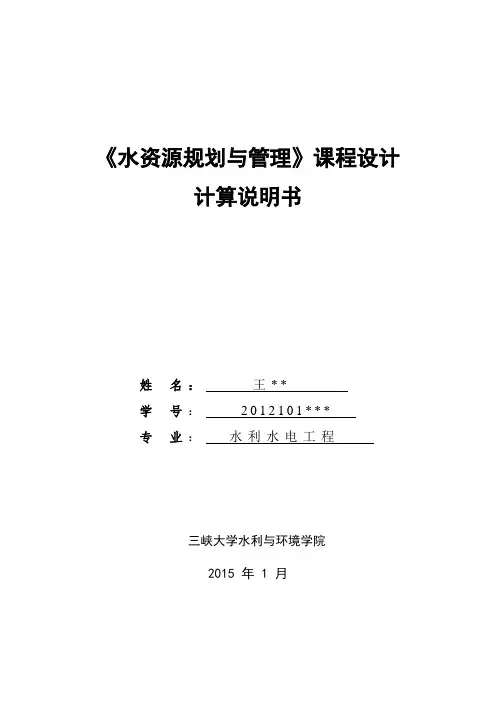
《水资源规划与管理》课程设计计算说明书姓名:王**学号:2012101***专业:水利水电工程三峡大学水利与环境学院2015 年 1 月目录1、设计目的 (3)2、设计基本资料 (3)3、洪水标准确定 (3)3.1设计洪水标准 (3)3.2校核洪水标准 (4)4、洪水调节方案一 (4)4.1 设计标准洪水调节 (5)4.1.1下泄流量计算 (5)4.1.2列表试算法调洪演算 (6)4.2.2列表试算法调洪演算 (9)5、洪水调节方案二 (13)5.1 设计标准洪水调节 (13)5.1.1下泄流量计算 (13)5.1.2列表试算法调洪演算 (15)5.2校核标准洪水调节 (18)5.2.1下泄流量计算 (18)5.2.2列表试算法调洪演算 (18)6、方案对比分析 (21)7、小结 (21)1、设计目的1、洪水调节目的:定量地找出入库洪水、下泄洪水、拦蓄洪水的库容、水库水位的变化、泄洪建筑物型式和尺寸间的关系,为确定水库的有关参数和泄洪建筑型式选择、尺寸确定提供依据。
2、掌握列表试算法的基本原理、方法、步骤及各自的特点。
3、了解工程设计所需洪水调节计算要解决的课题。
4、培养学生分析问题、解决问题的能力。
2、设计基本资料某水库以灌溉、防洪为主,兼有发电、供水、养殖等综合效益的大(2)型水利水电枢纽工程,水库承雨面积450km2,水库总库容2.408亿m3。
挡水建筑物为粘土心墙代料坝,最大坝高38.26m。
溢洪道为开敞式宽顶堰,溢洪道堰顶高程102.70m,采用3孔8m×6m(宽×高)的弧形门控制。
水库正常蓄水位107.00m。
洪水调度自正常蓄水位起调,当设计洪水小于正常蓄水位所对应的最大下泄流量时,控制闸门开度,使下泄流量与来流量相等;当等于、大于这一下泄流量时,则闸门全开。
洪峰过后,水位回落至正常蓄水位,则下闸控制,维持正常蓄水位不变。
由于该水库需进行除险加固方案设计,现对2个不同溢洪道改建方案进行方案比选,方案I保持溢洪道堰顶高程和单孔宽度不变,由现在的3孔改为5孔;方案II降低溢洪道堰顶高程至Xm,扩大单孔宽度至12m,保持孔数不变。
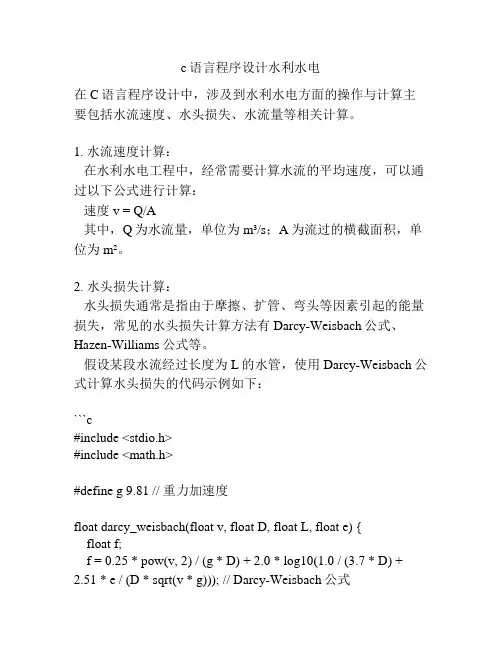
c语言程序设计水利水电在C语言程序设计中,涉及到水利水电方面的操作与计算主要包括水流速度、水头损失、水流量等相关计算。
1. 水流速度计算:在水利水电工程中,经常需要计算水流的平均速度,可以通过以下公式进行计算:速度v = Q/A其中,Q为水流量,单位为m³/s;A为流过的横截面积,单位为m²。
2. 水头损失计算:水头损失通常是指由于摩擦、扩管、弯头等因素引起的能量损失,常见的水头损失计算方法有Darcy-Weisbach公式、Hazen-Williams公式等。
假设某段水流经过长度为L的水管,使用Darcy-Weisbach公式计算水头损失的代码示例如下:```c#include <stdio.h>#include <math.h>#define g 9.81 // 重力加速度float darcy_weisbach(float v, float D, float L, float e) {float f;f = 0.25 * pow(v, 2) / (g * D) + 2.0 * log10(1.0 / (3.7 * D) +2.51 * e / (D * sqrt(v * g))); // Darcy-Weisbach公式return f * L;}int main() {float v, D, L, e, loss;printf("请输入水流速度v(m/s):");scanf("%f", &v);printf("请输入水管直径D(m):");scanf("%f", &D);printf("请输入水流经过长度L(m):");scanf("%f", &L);printf("请输入水管相对粗糙度e(m):");scanf("%f", &e);loss = darcy_weisbach(v, D, L, e);printf("水头损失为:%f\n", loss);return 0;}```3. 水流量计算:水流量是指单位时间内流过某一水面横截面的流体体积,可以通过以下公式进行计算:Q = A * v其中,Q为水流量,单位为m³/s;A为流过的横截面积,单位为m²;v为水流速度,单位为m/s。
在此先预祝老师新春快乐,合家幸福,万事如意!课程名称:洪水调节课程设计指导老师:玄英姬班级:网选1班学号::洪水调节课程设计一、课程设计目的洪水调节目的:定量地找出入库洪水、下泄洪水、拦蓄洪水的库容、水库水位的变化、泄洪建筑物型式和尺寸间的关系,为确定水库的有关参数和泄洪建筑型式选择、尺寸确定提供依据。
分别对设计洪水标准、校核洪水标准,按照上述拟定的泄洪建筑物的类型、尺寸和水库运用方式,分别采用列表试算法和半图解法推求水库下泄流量过程,以及相应的库容、水位变化过程。
二、设计基本资料某水利枢纽工程以发电为主,兼有防洪、供水、养殖等综合效益,电站装机为5000KW,年发电量1372×104 kw·h,水库库容0.55亿m3。
挡水建筑物为混凝土面板坝,最大坝高84.80m。
溢洪道堰顶高程519.00m,采用3孔8m×6m(宽×高)的弧形门控制。
水库正常蓄水位525m,电站发电引用流量为10m3/s。
本工程采用3孔溢洪道泄洪,设计洪水来临时,用左右2孔泄洪;校核洪水来临时,用3孔泄洪。
在洪水期间洪水来临时,先用闸门控制下泄流量q并使其等于洪水来水量Q,使水库水位保持在防洪限制水位不变;当洪水来水量Q继续增大时,闸门逐渐打开;当闸门达到全开后,就不再用闸门控制,下泄流量q 随水库水位Z的升高而增大,流态为自由流态,情况与无闸门控制一样。
三、洪水调节演算一、洪水标准的确定1.工程等别的确定由设计对象的基本资料可知,该水利枢纽工程以发电为主,并兼有其他综合效益,电站装机为0.5⨯104kW,水库库容0.55⨯108m3。
若仅由装机容量0.5⨯104kW 为指标,根据下表所示的“水利水电工程分等指标”,可将工程等别定为Ⅴ;若仅以水库总库容0.55⨯108m3为指标,则可将工程等别定为Ⅲ。
综合两种指标,取等级最高的Ⅲ等为工程最终等别。
水利水电工程分等指标工程等别 工程类型工程规模水库总库容(亿方)防洪治涝灌溉供水发电保护城镇及工矿企业保护农田(万亩)治涝面积(万亩)灌溉面积(万亩)供水对象重要性装机容量(万千瓦)Ⅰ大(1)型≥10特别重要≥500≥200≥150特别重要≥120Ⅱ大(2)型10~1.0重要500~100200~60150~50重要120~30Ⅲ中型1.0~0.1中等100~3060~1550~5中等30~5Ⅳ小(1)型0.10~0.01一般30~515~35~0.5一般5~1Ⅴ小(2)型0.01~0.001 <5<3<0.5 <12.洪水标准的确定该水里工程的挡水建筑物为混凝土面板坝(基本资料可知),由已确定的为Ⅲ等的工程等别,根据下表《水工建筑物洪水标准》,可查得,该工程设计洪水标准为100—50年,校核标准为1000—500年,不妨取设计标准为100年,校核洪水标准为1000年。
《水资源规划及利用》课程设计计算说明书姓名:学号:专业:三峡大学水利与环境学院2017年1月1、设计目的.................................................. 0..2、设计基本资料............................................. .0..3、列表试算法推求水库下泄流量过程 (2)3.1洪水标准确定......................................... 2.3.1.1设计洪水标准................................... 3.3.1.2校核洪水标准................................... 3.3.2 设计标准洪水调节.....................................4.3.2.1下泄流量计算...................................4.3.2.2列表试算法调洪演算 (6)3.3校核标准洪水调节..................................... 9.4、半图解法推求水库下泄流量过程 (12)4.1洪水标准确定........................................ 1.24.2设计标准洪水调节 (13)4.2.1计算并绘制单辅助线 (13)4.2.2半图解法调洪演算 (15)4.3校核标准洪水调节 (17)5、成果分析及结论 (20)6、小结 (20)洪水调节1、设计目的1) 洪水调节目的:定量地找出入库洪水、下泄洪水、拦蓄洪水的库容、水库水位的变化、泄洪建筑物型式和尺寸间的关系,为确定水库的有关参数和泄洪建筑型式选择、尺寸确定提供依据;2) 掌握列表试算法的基本原理、方法、步骤及各自的特点;3) 了解工程设计所需洪水调节计算要解决的课题;4) 培养学生分析问题、解决问题的能力。
C-7 水电站等出力调节计算(试算法)程序作者唐文华(水电部天津勘测设计院)校核潘东海(水电部天津勘测设计院)一、功能在已知入库流量过程、库容曲线、坝址下游水位流量曲线、调节期初、末时段的库容等资料时,可以利用本文程序进行调节期内的等出力调节计算,得到所需要的调节流量、库容、水位、水头和出力等水能指标过程。
二、变量说明程序中有输入变量25个,其它变量66个,共计变量91个。
变量的名称和意义列于表1。
三、计算方法概述用试算法,程序以双重循环完成试算,即:内层循环计算出力N(K),使其与NT差值小于等于EP;外层循环使计算时期末的库容V(AC)与要求的库容VV之差值小于等于EC。
计算步骤如下:(一)进行等量计算,取其各时段处理的平均值,乘上大于1的系数后作为等出力计算的初始出力NT(即NT-A0*NS/F)。
等流量计算的调节流量QC为等出力计算的初始流量。
(二)进行等出力计算,将QC赋予发电流量QO,用时段水量平衡式:V=QI-QO+VB计算库容V,并进二计算出力NC。
用下式判断计算是否结束,DN<=EP如果上式满足,则结束本时段计算,转如下时段计算。
否则,修改QO(或有事修改NT)后,继续循环计算,直到满足要求为止。
(三)各时段计算结束后,检查期末库容V(AC)是否满足下式:Z<=EC如果上式满足,则完成了整个调节期的等出力调节计算。
否则,修改NT(有时修改QI(K)后,重新计算,直到满足要求为止。
四、几点说明使用本文程序时需要注意的总是说明如下:(一)程序适用于大、中、小型水电站的等出力调节计算。
出力最小计算到1千瓦(或更小),准确到2千瓦(或更小)。
期末库容差计算到0.1秒立米月(或更小),准确到0.2秒立米月(或更小)。
(二)计算题目:已知正常蓄水位和有效库容,计算出力等过程;或已知正常蓄水位,求得最大出力过程情况下的有效库容,等等。
(三)可以单独利用本程序进行等出力调节计算,同时各子程序可以编入其它程序(供调用)。
姓名学号指导老师根据建筑物的等级,可确定设计洪水标准的频率为3.33%、校核洪水标准的频率为0.5%,起调水位是227.0m,溢流堰宽度56.9m。
一.设计洪水调节的计算(一)列表试算法:1.计算并绘制q—V,V—Z和q—Z曲线表一:设计洪水标准(p=3.33%)时水库q—V关系计算表2.确定调洪起始条件。
起调水位为227.0m ,相应库容查表一得为14.632万m 3,初始下泄流量查表一得为0 m 3/s 。
3.用试算法进行调洪计算。
计算时段为0.5h ,见表二表二:设计洪水标准(P=3.33%,)4.由表二绘制Q—t,q—t和Z—t曲线如下所示:5.由Q—t,q—t曲线查得设计洪水标准时最大泄量为1585.50 m3/s,由表二查得水库最高水位为232.613 m。
(二)半图解法1.由上述列表试算法得到的q~V曲线计算并绘制q~V/△t+q/2辅助曲线,见表三。
表三:q=f(V/△t+q/2)辅助曲线计算表(p=3.33%)2.调洪计算求q~t过程和库水位过程。
计算过程见表四。
表四:水库半图解法调洪计算表(p=3.33%)3.绘制Q~t与q~t曲线,求q m与Z设。
4.由上表查得设计洪水标准时最大泄量为1602.02m3/s,水库最高水位为232.659m。
二.校核洪水调节的计算(一)列表试算法:1.计算并绘制q—V,V—Z和q—Z曲线表一校核洪水标准(p=0.5%)时水库q—V关系计算表2.确定调洪起始条件。
起调水位为防洪限制水位227.0 m,相应库容查表一得为14.632万m3,初始下泄流量查表一得为0 m3/s。
3.确定时刻0~2h和13h后小于防洪限制水位下的泄流量,为保持防洪限制水位不变,应使下泄水位等于来水量。
其余时刻水库进行洪水调节,用试算法进行调洪计算。
计算时段为0.5h,见表二表二:校核洪水标准(p=0.5%)4.由表二绘制Q—t,q—t和Z—t曲线如下所示:5.由Q—t,q—t曲线查得设计洪水标准时最大泄量为2394.46 m3/s,由表二查得水库最高水位为234.297 m。
《洪水调节课程设计》任务书一、设计目的1.洪水调节目的:定量地找出入库洪水、下泄洪水、拦蓄洪水的库容、水库水位的变化、泄洪建筑物型式和尺寸间的关系,为确定水库的有关参数和泄洪建筑型式选择、尺寸确定提供依据;2.掌握列表试算法和半图解法的基本原理、方法、步骤及各自的特点;3.了解工程设计所需洪水调节计算要解决的课题;培养学生分析问题、解决问题的能力。
二、设计基本资料1.某水利枢纽工程以发电为主,兼有防洪、供水、养殖等综合效益,电站装机为5000KW,年发电量1372×104 kw·h,水库库容0.55亿m3。
挡水建筑物为混凝土面板坝,最大坝高84.80m。
溢洪道堰顶高程519.00m,采用2孔8m×6m(宽×高)的弧形门控制。
水库正常蓄水位525.00m。
电站发电引用流量为10 m3/s。
2.本工程采用2孔溢洪道泄洪。
在洪水期间洪水来临时,先用闸门控制下泄流量q并使其等于洪水来水量Q,使水库水位保持在防洪限制水位不变;当洪水来水量Q继续增大时,闸门逐渐打开;当闸门达到全开后,就不再用闸门控制,下泄流量q随水库水位z的升高而增大,流态为自由流态,情况与无闸门控制一样。
3.上游防洪限制水位524.8m(注:X=524.5+学号最后1位/10,即524.5m-525.4m),下游无防汛要求。
三、设计任务及步骤分别对设计洪水标准、校核洪水标准,按照上述拟定的泄洪建筑物的类型、尺寸和水库运用方式,分别采用列表试算法和半图解法推求水库下泄流量过程,以及相应的库容、水位变化过程。
具体步骤:1.根据工程规模和建筑物的等级,确定相应的洪水标准;2.用列表试算法进行调洪演算:①根据已知水库水位容积关系曲线V~Z和泄洪建筑物方案,用水力学公式求出下泄流量与库容关系曲线q~Z,并将V~Z,q~Z绘制在图上;②决定开始计算时刻和此时的q1、V1,然后列表试算,试算过程中,对每一时段的q2、V2进行试算;③ 将计算结果绘成曲线:Q ~t 、q ~t 在一张图上,Z ~t 曲线绘制在下方。
基于列表试算法的X水库洪水调节计算软件开发作者:秦峰来源:《科学与财富》2019年第24期摘要:X水库为某水库简化模型,对其进行洪水调节计算,能够得到该水库在不同频率的入库洪水过程线下对应的兴利库容和防洪高水位,该计算过程及所得结果对于对于该水库适时进行控制和分配下游用水、提高水的综合利用作用等方面具有重要的作用和意义。
本文通过运用洪水调节计算“列表试算法”的基本原理,结合Visua Basic 6.0软件编程,根据洪水调节计算软件的开发过程,编写适合洪水调节计算的软件。
关键词:X水库;洪水调节;列表试算法正文:某河是渭河南岸较大的一级支流,发源于秦岭北麓太白山区,流域面积778.7km2,干流全长51.5km,河道比降1/60~1/70。
流域内林木茂盛,植被良好,水流清澈,水质优良。
该河干流上有一水文站A,控制流域面积686km2。
拟在该河干流上修建一水库X,其坝址位于水文站上游1.5公里处,控制流域面积673km2。
该水库将承担着下游和渭河的防洪任务,下游的防洪标准为20年一遇洪水,水库设计标准为100年一遇洪水,校核标准为1000年一遇洪水。
本文以该简化模型,结合下泄流量与库容、水位的关系,运用列表试算法,对洪水调节计算进行分析并编程,得到可以计算出水库兴利库容的软件。
一、X水库水文资料整理与分析根据已知的拟建X水库的水文资料,可初步梳理已知条件,并对数据进行初步的处理如下:1.拟建X水库的防洪限制水位是788.5m即起调水位为788.5m;2.水库的总泄流量等于溢洪道下泄流量与输水洞下泄流量之和:q泄总=q堰+q洞。
其中:溢洪道为开敞式无闸门,堰型为曲线型实用堰,断面为矩形,宽度为30米,堰顶高程为788.5m,泄流能力利用堰流公式计算:q堰=??1×??×??1.5=48??1.5;水库输水洞在汛期按其输水能力泄洪,输水洞进口高程为722m,内径为4m,设计流量为70m3/s。
《洪水调节课程设计》任务书一、设计目的1.洪水调节目的:定量地找出入库洪水、下泄洪水、拦蓄洪水的库容、水库水位的变化、泄洪建筑物型式和尺寸间的关系,为确定水库的有关参数和泄洪建筑型式选择、尺寸确定提供依据;2.掌握列表试算法和半图解法的基本原理、方法、步骤及各自的特点;3.了解工程设计所需洪水调节计算要解决的课题;培养学生分析问题、解决问题的能力。
二、设计基本资料1.某水利枢纽工程以发电为主,兼有防洪、供水、养殖等综合效益,电站装机为5000KW,年发电量1372×104kw·h,水库库容亿m3。
挡水建筑物为混凝土面板坝,最大坝高。
溢洪道堰顶高程,采用2孔8m×6m(宽×高)的弧形门控制。
水库正常蓄水位。
电站发电引用流量为10 m3/s。
2.本工程采用2孔溢洪道泄洪。
在洪水期间洪水来临时,先用闸门控制下泄流量q并使其等于洪水来水量Q,使水库水位保持在防洪限制水位不变;当洪水来水量Q继续增大时,闸门逐渐打开;当闸门达到全开后,就不再用闸门控制,下泄流量q随水库水位z的升高而增大,流态为自由流态,情况与无闸门控制一样。
3.上游防洪限制水位(注:X=+学号最后1位/10,即),下游无防汛要求。
三、设计任务及步骤分别对设计洪水标准、校核洪水标准,按照上述拟定的泄洪建筑物的类型、尺寸和水库运用方式,分别采用列表试算法和半图解法推求水库下泄流量过程,以及相应的库容、水位变化过程。
具体步骤:1.根据工程规模和建筑物的等级,确定相应的洪水标准;2.用列表试算法进行调洪演算:①根据已知水库水位容积关系曲线V~Z和泄洪建筑物方案,用水力学公式求出下泄流量与库容关系曲线q~Z,并将V~Z,q~Z绘制在图上;②决定开始计算时刻和此时的q1、V1,然后列表试算,试算过程中,对每一时段的q2、V2进行试算;③将计算结果绘成曲线:Q~t、q~t在一张图上,Z~t曲线绘制在下方。
3. 用半图解法进行调洪计算:① 绘制三条曲线:()2t 1q V Z f -=∆,()2t 2q V Z f +=∆,()Z f=q ;② 进行图解计算,将结果列成表格。
4. 比较分析试算法和半图解法调洪计算的成果。
四、 时间安排和要求1. 设计时间为1周;2. 成果要求:① 设计说明书编写要求条理清楚、附图绘制标准;② 列表试算法要求采用手工计算,熟悉过程后可编程计算,如采用编程计算需提供程序清单及相应说明;③ 设计成果请独立完成,如有雷同则二者皆取消成绩,另提交成果时抽查质询。
五、 参考书3. 《水利水电工程等级划分及洪水标准》(SL252-2000)4. 《水利水能规划》 附录:一、 堰顶溢流公式2/302q H g m nb ⋅=ε式中:q ——通过溢流孔口的下泄流量,m 3/s ;n ——溢流孔孔口数;b ——溢流孔单孔净宽,m ; g ——重力加速度,s 2;ε——闸墩侧收缩系数,与墩头形式有关,初步计算可假设为; m ——流量系数,与堰顶形式有关,可查表,本工程取;H 0——堰顶水头,m 。
二、设计洪水过程三、水位-库容曲线和库容表库容表高程(m)450460470480490500505库容(104m3)018高程(m)510515520525530535540库容(104m3)6670四、工程分等分级规范和洪水标准五、调洪计算成果表频率设计洪水校核洪水项目列表试算法最大泄量(m3/s)s m3/s水库最高水位(m)半图解法最大泄量(m3/s)s s水库最高水位(m)洪水调节演算过程一、洪水标准的确定1.工程等别的确定:由设计对象的基本资料可知,该水利枢纽工程以发电为主,兼有防洪、供水、养殖等其他综合效益,电站装机为5000kW,水库库容⨯。
若仅由装机容量5000kW为指标,根据“水利水电工程分等指标”,可将工程等别定为Ⅴ;若仅以水库总库容⨯为指标,则可将工程等别定为Ⅲ。
综合两种指标,取等级最高的Ⅲ等为工程最终等别。
2.洪水标准的确定:该水利工程的挡水建筑物为混凝土面板坝,由已确定的为Ⅲ等的工程等别,根据“山区,丘陵区水利水电工程永久性水工建筑物洪水标准”,可查得,该工程设计洪水标准为100~50年,校核标准为1000~500年,不妨取设计标准为100年,校核洪水标准为1000年。
二、试算法洪水调节计算1.计算并绘制水库的q=f(V)关系曲线:应用式2/32q Hgmnb⋅=ε,根据不同水库水位计算H与q,再由H~V关系曲线查得V,并计算于下表,绘制q=f(V) 关系曲线图如下。
2.3.4.5. 确定调洪的起始条件:起调水位也是防洪限制水位,Z=。
相应库容×104m 3。
在洪水期间洪水来临时,先用闸门控制下泄流量q 并使其等于洪水来水量Q ,使水库水位保持在防洪限制水位不变;当洪水来水量Q 继续增大时,闸门逐渐打开;当闸门达到全开后,就不再用闸门控制,下泄流量q 随水库水位z 的升高而增大,流态为自由流态,情况与无闸门控制一样。
由公式:10H 2g m nb Q q 230+⋅==ε=⨯⨯⨯()5.12.681.92⨯m 3/s 得调洪开始时的下泄流量为 m 3/s 。
所以在第一时段,以闸门控制入库流量等于下泄流量;以后时段闸门全开不再控制,下泄流量由试算计算。
6. 列表试算泄流量q ,本过程采用C 语言编程试算。
① 基本原理:根据水库容积曲线V=f (Z )和堰顶溢流公式q=f (H ),得出蓄泄方程q=f (V )。
联立水量平衡方程)q (2t121212q Q Q V V --++=∆f(V)q =可得q=f(V)=g (q ),即q=g (q )。
② 编程公式的主要过程a) 已知的电站发电引用流量为10m 3/s ,结合堰顶溢流公式,得出下泄流q=nb εm 230H g 2+10。
(1) b) 水位高程Z 与堰顶水头H 的关系。
基本材料可知溢洪道堰顶高程为519m 则H=Z-519m ;c) 水库容积曲线V=f (Z )的近似化。
根据该设计的蓄泄情况,水位高程的变化范围在525m~535m 之间,又由于水库容积曲线在水位高程属525m~535m 之间的变化率较小,为方便计算,故可将其分段直线化以简化、近似计算。
由水位—库容表V=f (Z )及上式H=Z -519m ,可得V=f (H ),易算出H=g (V )= 02.18268.3591V - []9.55938.4683V ,∈ 22.21548.3226V - []0.66709.5593V ,∈。
(2)联立(1)、(2)式得10V g g 2m nb =q 23+)(ε。
(3) d )将(3)式与水量平衡方程联立。
得 )q (2t 121212q Q Q V V --++=∆10V g g 2m nb =q 23+)(ε。
(4) e )C 语言程序源代码如下:#include<> #include<> void main() {float V1,V2,Q1,Q2,q1,q2,q3, t=; printf("V1="); scanf("%f",&V1); printf("Q1="); scanf("%f",&Q1); printf("Q2="); scanf("%f",&Q2); printf("q1="); scanf("%f",&q1); printf("q2="); scanf("%f",&q2); printf("\n\n"); loop: {V2=V1+ (Q1+Q2-q2-q1) * t/2;if (V2>= && V2<= q3=(pow(/,)*+10;else if (V2>= && V2<= q3=(pow(/,)*+10; }if (fabs(q3-q2)> { q2=q3;goto loop; }printf("q2=%f\n",q3); printf("V2=%f\n\n\n",V2); }7. 对设计洪水计算时段平均入库流量和时段入库水量。
① 将洪水过程表中P=1%的洪水过程线划分计算时段,初选时段Δt=1h=3600填入下表第一栏,表中第二栏为按计算时段摘录的入库洪水流量,计算的时段平均入库流量和时段入库水量分别填入第三栏和第四栏。
泄流量的计算见第五,六,七栏。
从表中第一,五栏可绘制下泄流量过程线。
第一,十栏可绘制水位过程线;② 为了枯水期能保证兴利部门的用水需求,当水位再次下降到调洪水位时,又需要用闸门控制下泄流量q 并使其等于洪水来水量Q ,使水库水位保持在防洪限制水位不变。
见第15时段q=f (V )的程序计算截图; ③ 绘制Q~t 与q~t 曲线,如图所示。
最大下泄流量m ax q = m 3/s 发生在t=8h 时,正好是q~t 曲线与Q~t 曲线的交点,即为所求的最大下泄流量;④ 推求设计调洪库容设V 和设计洪水位设Z 。
m ax q =对应的库容和水位分别为万m 3和,减去堰顶以下的库容万m 3 即可得设V =万m 3,设Z = m 。
第2时段试算法程序计算截图第时段试算法的程序计算截图8. 对校核洪水计算时段平均入库流量和时段入库水量。
① 将洪水过程表中P=%的洪水过程线划分计算时段,初选时段Δt=1h=3600填入下表第一栏,表中第二栏为按计算时段摘录的入库洪水流量,计算的时段平均入库流量和时段入库水量分别填入第三栏和第四栏。
泄流量的计算见第五,六,七栏。
从表中第一,五栏可绘制下泄流量过程线。
第一,十栏可绘制水位过程线。
② 为了枯水期能保证兴利部门的用水需求,当水位再次下降到调洪水位时,又需要用闸门控制下泄流量q 并使其等于洪水来水量Q ,使水库水位保持在防洪限制水位不变。
见第20时段q=f (V )的程序计算截图。
③ 绘制Q~t 与q~t 曲线,如图所示。
最大下泄流量m ax q =s 发生在t=8h时,正好是q~t 曲线与Q~t 曲线的交点,即为所求的最大下泄流量。
④ 推求校核调洪库容校V 和设计洪水位校Z 。
m ax q =对应的库容和水位分别为万m 3和,减去堰顶以下的库容万m 3 即可得校V =万m 3,校Z = m 。
第2时段试算法程序计算截图第时段试算法程序计算截图某水库校核调洪计算表三、 半图解法洪水调节计算(以设计洪水标准进行调洪演算为例子) 1. 计算并绘制2qt V ~q +∆辅助线。